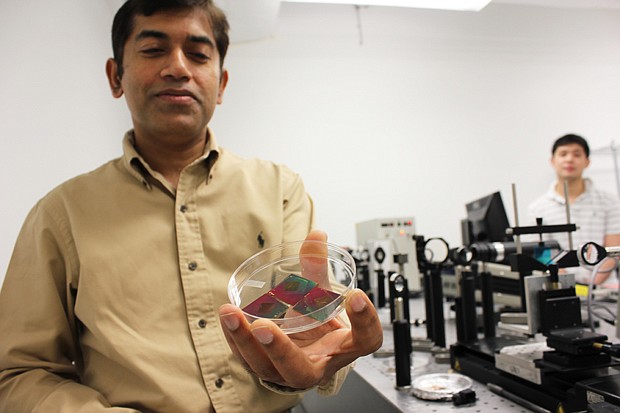- April 22, 2024
-
-
Loading

Loading

In America’s stumbling economy, some might argue that a professor’s income doesn’t accurately reflect the amount of work they do.
But Jayan Thomas, an associate professor at the University of Central Florida – seems to have struck gold.
In his office on Research Parkway, just a half mile from UCF’s main campus, Thomas has been analyzing tiny gold nanoparticles for the past year in an effort to design a pair of goggles that could change how a pilot sees during flight.
Ironically he’s working with something too small to see. Take a hair off your head and split it into about 100,000 parts. One of those is equal to a nanometer - the size of gold nanoparticles.
Tiny pieces of gold has have had their place in the past. Back in the middle ages churches would use gold particles to give a shimmer to artistic window glass. But now they’re making a comeback that’s spreading across the science word.
Thomas got started on the project when one of his colleagues, Dr. Rongchao Jin, an associate professor at Carnegie Mellon University, developed the particles for other applications.
Now the two are working together to engineer the energy levels of the particle to manipulate the intensity of light passing through.
While the scientific term used for this type of application is called optical-limiting, the more commonly used phrase is “diffusing the laser light.”
In the experiments, Thomas has been working with gold-25 nanoclusters, each one having exactly 25 atoms of gold in the particle.
“In this case, when you irradiate it with this light, as you increase the intensity of the light, the output light goes down,” Thomas said.
That light radiation combined with the laser light has been a major problem for pilots since the early ’90s.
“In a big city, it is possible for someone in an office building to point a laser that would affect a pilot’s eyesight during landing or take off,” Thomas said.
In flight, it is essential for pilots to see everything, even while wearing goggles. With that, the pilots need to have some type of eyewear that can transmit light at normal intensities.
That’s what the gold nanoclusters are set out to do – increase the intensity of light, while lowering transmission.
So far, Thomas and his colleagues have only tested the green light and how the gold clusters absorb that light. For the actual pair of protective glasses, it will need the materials capable of absorbing all colors.
Both Thomas and Jin have plans to develop a protective pair of eyewear with these gold nanoclusters on them for the pilots to wear during flight.
“For future work, understanding the absorption in nanoclusters is to be pursued, together with efforts to map out what factors can further improve the optical limiting efficiency of nanoclusters,” Jin said.
In order to optimize the eyeglasses, all of the different wavelengths of laser light must be tested.
While Thomas is busy working, one graduate student, Panit Chantharasupawong, spends the majority of his time — around 8 to 10 hours daily — working in the lab testing the different materials and manipulating nanoclusters.
Despite the intensity of the project, it won’t be perfected in one night. Thomas said he expects the development of a pair of these glasses to take another five years.
If the glasses were to hit the market today, Thomas predicts they would cost around $500-$1,000. But in five years, that price could double. There’s no escaping the changing price of gold, the value of which used to be the basis for the world economy.
Though the gold standard may be a thing of the past, gold nanoclusters seem to be a bright part of Thomas’ team’s future.